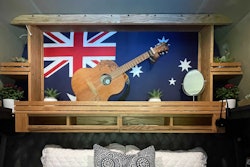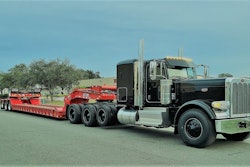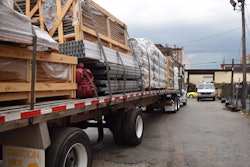Find all the pieces of this series in the anchor story at this link: Hotshot trucking retains its fundamental allure
Plenty of truckers choose hotshot over heavier trucking niches for factors such as lower equipment costs, less advanced driving skills, easier equipment serviceability and more. Such aspects of downsizing were a refuge from the topsy-turvy Class 8 freight spot market for longtime independent owner-operator Debbie Desiderato, who recently returned to the small-truck world.
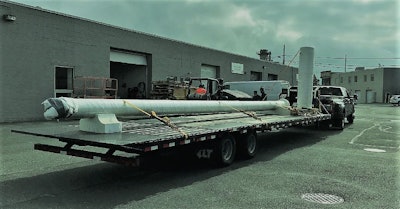 This extreme-short-haul job (12 miles), a flagpole delivered by Desiderato paying $25/mile, shows the kind of odd but highly profitable loads available to hotshotters who know where to look.
This extreme-short-haul job (12 miles), a flagpole delivered by Desiderato paying $25/mile, shows the kind of odd but highly profitable loads available to hotshotters who know where to look.While truckers in May were protesting dirt-cheap rates and brokers’ alleged “reverse price gouging” as coronavirus slowdowns took hold, the downtrend wasn’t all that new for the Walkabout Transport owner-operator. Desiderato had long been watching her customers’ freight dry up. She had for years run trade-show-related freight, largely, with a couple of steady brokers — a niche that turned out to fit squarely in the pandemic’s crosshairs. She made do on an arrangement with a military-freight-specialized broker, but business was slow, and rates were lackluster.
She sold her Kenworth and dry van trailer and found a well-priced 2017 Ford F350 with only 17,000 miles on it at a North Carolina dealer. A new Load Trail 40-foot flatbed with a gooseneck hitch built for heavy-duty use in Louisiana completed the package, outfitted with a hydraulically controlled dovetail.
After registration delays, by July she was working, intending to specialize in automobiles. Her first series of loads came by way of a friend in New York who “had 500 vehicles to clear from a lot in Staten Island to a Connecticut auction,” she said. Most of it was “bigger stuff — crew-cab pickups and Sprinter vans that a nine-car hauler could only take three, four at a time.” But she could get half that or more on her flatbed, with $1 to $2 per vehicle per mile. “That was a good start to get my feet re-wet,” she adds.

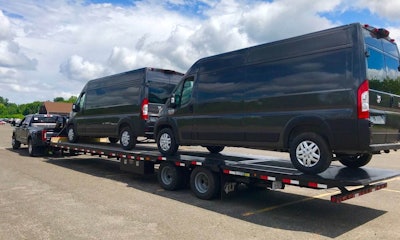 An example from that series of loads — Desiderato may end up specializing in such vehicles over time, though the flatbed offers plenty versatility in types of freight to haul.
An example from that series of loads — Desiderato may end up specializing in such vehicles over time, though the flatbed offers plenty versatility in types of freight to haul.That’s right: Desiderato previously had done similar hauls. She worked for a car-haul company in 1999 that closed shortly thereafter, then drove for high-end car dealerships before upgrading to a Class 8.
Two decades ago she began building her customer base with nothing more than “a fax out to my local high-end dealerships – and it was an unsolicited fax – where I said, ‘There’s a new transporter in town.’” She ended up moving “Jags, Porsches and Mercedes” for dealers. “I’ll probably end up doing that again, but this time with the bigger vehicles.”
While she had heard that car-haul business had slowed with COVID-19, that didn’t seem to be the case for her old car-haul associates in early summer. “They all have more work than they can handle, and everybody’s happy,” she said.
The income from her next job more than paid for the monthly $156 fee to subscribe to the Central Dispatch auto-specialty load board where she found it. Even though the cargo wasn’t vehicular, the big flagpole had been posted by an automobile transport company and needed to move only 12 miles. She took the $300 job and moved it to a traffic island in a nearby town.
Central Dispatch is the gold standard load board for automobile haulers. “It’s more expensive” – subscriptions start at around $90 monthly – than what Desiderato is used to in DAT, but “the rates are way better,” she said.
She gives the example of a recent 100-mile radius search on DAT for loads at or under her maximum payload — 20,000 pounds. “The search returned six available loads,” she said. “I did the same thing on Central Dispatch, but narrowed the radius to 20 miles. There were 327 vehicles in the results. The difference is night and day.”
Update: Since this story published originally in late-summer 2020, Desiderato had made yet another move, this one back to a Class 8 Western Star, for the first time hauling as part of a logging operation near her Virginia home base.




